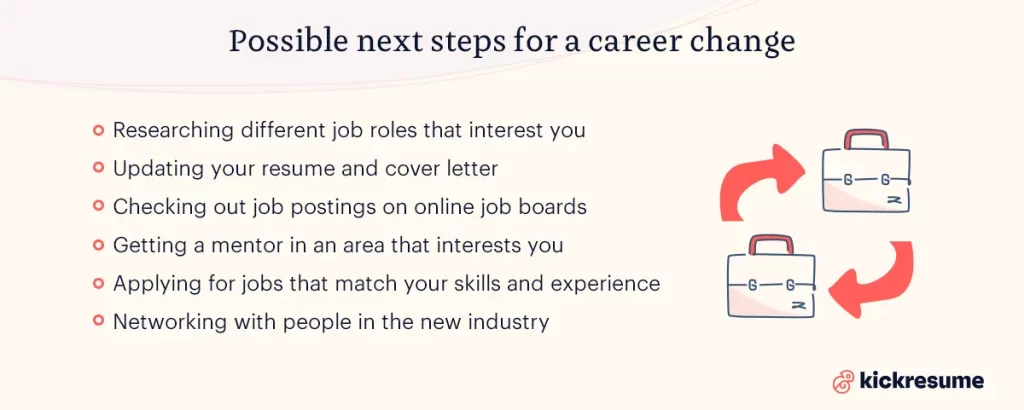Making a career change can be a daunting task. Still, it can be made easier by following proven coaching exercises for a successful career change.
In this blog post, we'll discuss 5 useful coaching exercises, according to a certified career coach Naomi Rothwell-Boyd.
She has coached people from a variety of backgrounds and industries, from graduates to senior executives.
And her coaching exercises will help you assess your skills, identify your passions, and set realistic goals for yourself.
How do you define a successful career change?
Success ultimately depends on your own definition. But there are some key factors that will help you measure it when changing careers, such as:
- Achieving specific goals
- Finding fulfillment in your work
- Improving your quality of life
If you can say a career change would lead to a noticeable improvement in one or more of these big factors, then you're on the right way.
You also need to consider the magnitude of the change you're looking to make. A successful change for one person might not be major enough for another.
Conversely, what seems like your friend's idea of success might be far too dramatic for you at this stage of your life.
Regardless of what your definition of a successful career change is, there are reliable coaching exercises giving you the best chance at making it happen.
What are coaching exercises?
Coaching exercises are activities or questions that help you explore your goals, identify your values, and get clarity on the steps you need to take to achieve success.
Such exercises are often used in coaching sessions with a professional coach.
However, there are 5 great exercises that you can do on your own and in your own time.
Doing these exercises can help simplify a complex task, such as changing careers. They can also provide a much-needed structure and support during a time of transition.
"A career coach's role is not to do the hard work for you, but to challenge you to make the right decisions for you," says Naomi Rothwell-Boyd, accredited career coach and founder of Tribe And Seek, a career coaching company.
"Think of a career coach much like a personal trainer. They won't do the workout for you, but they'll help you accelerate your progress. So, there are tried and tested exercises that almost anyone can do to make serious progress."
Of course, there are many different types of coaching exercises.
Together with Naomi, we've selected five best that we believe are essential for anyone making a career change:

Exercise #1: Identify your biggest pain points
While it's often tempting to dive straight into setting lofty goals for ourselves, it's easier to look at what's not working.
When it comes to making a career change, it's important to understand what's not working in your current career. This includes identifying your biggest pain points.
Pain points are areas of your job that are causing you the most stress or frustration.
When you know what's stressing or frustrating you the most, you'll have a better understanding of what you want from a new career to make you happy and fulfilled.
Don't be afraid to be honest about your pain points with yourself. It can be difficult to face the things that are making us unhappy in our careers, but it's the first step on the road to change.
Here's what to do, according to Naomi:
- Start by examining what you don't like when working. Are there things about the company you don't like? Do you dislike the type of work? Are you being dragged back to the office? Are your co-workers the problem? Does the culture not work for you? Are you bored?
- Next, consider any impacts on your personal life. Does your job make it hard to spend time with family or friends? Does it interfere with your hobbies or interests? Does it make you miss important events?
- Finally, once you've identified your main pain points, try to order them based on their importance to you. Doing so will help you understand what areas are causing you the most distress. It will also give you a better idea of what needs to change for you to be happier in your career.
Exercise #2: Set SMART goals
The next coaching exercise for a successful career change includes re-writing your list of the biggest pain points as a list of the complete opposites.
In other words, you should write down a specific goal that's the opposite of every major pain point you want to change:
- For example, if one of your pain points is that you don't get enough time with your family, then you can set a specific goal of "make more time to spend with my family."
- Next, you need to define a measure of what an improvement should look like. For example, you could tweak the goal a bit and say "gain 6 more hours every week to spend with my family." This measurement gives you something to aim for and track progress against.
- The final step is to make sure your goal is achievable, realistic, and time-bound. So, you might say "In the next 3 months, I'll spend 6 more hours every week with my family."
This is now a SMART goal that you can take action to achieve.
Using this format to create the opposite goals for all your pain points is the easiest way to give yourself a good foundation and a plan to follow.
Exercise #3: Deal with the big rocks first
Now that you have a better understanding of where you want to be — what are the big rocks standing in your way?
We all have major obstacles to overcome. And dealing with them first is always the most productive strategy.
Of course, some people will face very few rocks, while others will face a lot of them.
According to Naomi, the key is to identify the ones that are going to take up the most time and energy to deal with:
- A big rock might be something like gaining new qualifications. If you need to study for a new degree or professional certification, this is going to take up a lot of time and energy. Hence, it's important to factor this in when making your career change plans.
- Other people might have more personal obstacles to deal with. For example, if you're a single parent, you might need to find childcare arrangements that work around your new job.
- Or if you're currently in a senior role, you might need to take a pay cut to get the type of job you really want.
These are all important considerations that need to be taken into account.
Once you've identified your major obstacles, make a plan for how you're going to overcome them. Knowing that you're making progress towards your goals will help to keep you on track and stay motivated.

Exercise #4: Make a list of possible next steps
The final Naomi's coaching exercise for a successful career change for this stage is to brainstorm a list of possible next steps.
This is an important step to take because it can help prevent you from feeling stuck or lost.
Making a list of possible next steps gives you a range of options to choose from. You can then pick the ones that align with your goals the most and start taking action.
Possible next steps might be:
- Researching different job roles that interest you
- Updating your resume and cover letter
- Checking out job postings on online job boards
- Getting a mentor in an area that interests you
- Applying for jobs that match your skills and experience
- Networking with people in the new industry
These are just a few examples, however, there'll be many more options depending on your situation.
Making this list will help you feel more in control of the process and give you a good starting point for taking action.
It's also a good idea to review and update your list regularly, as your goals and circumstances may change over time.
Exercise #5: Keep taking action daily
An American author once famously said:
Brushing your teeth once won't keep your teeth clean, it's the daily routine that makes all the difference.
Simon Sinek
The same is true for making a successful career change.
You need to keep taking action every day, even if it's just one small step at a time. This will help you stay on track and make progress toward your goals.
It can be helpful to set yourself a daily or weekly target for the number of actions you want to take.
For example, you might want to aim for 10 new job applications per week or 5 networking meetings per month.
Reaching these targets will help you stay motivated and focused on the task at hand. It's also essential to remember that not every action you take will lead to an immediate result.
The important thing is to keep taking those steps and progressing toward your goals.
Most people tend to think about the huge mountain they need to climb. They see a big goal and find it overwhelming at the start.
The best way to deal with this daunting feeling is to focus on the small steps you can take today.
Making a successful career change isn't an easy task, but it's possible with the right mindset and approach. And these five coaching exercises for a successful career change can help to give you a good foundation to start from!




